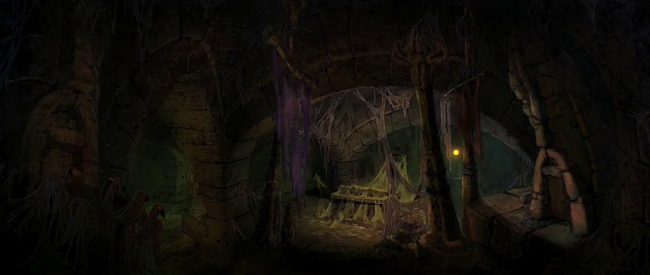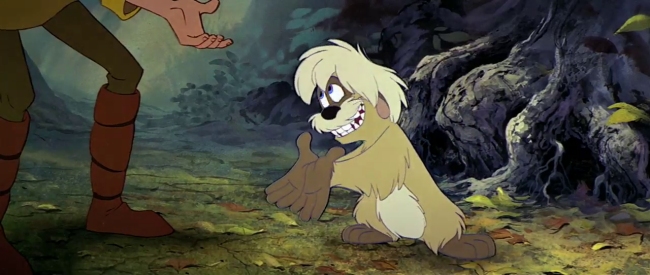
I saw 1985's The Black Cauldron when I was a kid and I remember at the time finding it to be a surprisingly disturbing film. Watching it as an adult a few nights ago, I can say it's still disturbing, for the same reasons, but now I don't think they were quite intentional. It's a film in which visual beauty coexists with uninspired animation and resonant menace functions alongside sloppy or lazy writing.
Like the first years of the Big Finish Doctor Who audio plays, when the television show wasn't on the air and the franchise was in a slump, one of the virtues of Disney's slump in the 70s and 80s was that they allowed themselves to experiment with darker material. I only wish Paramount would learn the same thing with Star Trek but they'd rather sue the only creative sparks happening for that franchise. I digress.

The biggest success for Disney from this period, which according to Robert Zemeckis they aren't currently happy about, is Who Framed Roger Rabbit, but in the same atmosphere, over a very long period, The Black Cauldron was percolating. I recommend reading the Wikipedia entry for a glimpse at some of the drama happening behind the scenes that led to the film's long gestation and the problems remaining in the final cut released to audiences. Somehow, during all the protracted process of making the film, no-one thought to make the characters into characters.

The movie is based on a series of novels based on a Welsh folk tale so maybe it's a matter of character removed rather than a failure to write characters to begin with. The best example is Gurgi (voiced by John Byner) who's sort of like Gollum minus every interesting character trait. We don't know where Gurgi came from, we don't know why he decided to devote himself to Taran (Grant Bardsley), the primary protagonist, we don't even find out what Gurgi is. He looks sort of like one of those videos of a schnauzer wearing a teddy bear body around its neck.

More importantly, none of the other characters ask these questions. The main characters form into a sort of standard Dungeons and Dragons party of adventurers without any apparent motivation other than that they're all aware of being the good guys in a movie. The animation, while fluid, is fittingly insensible for this and much of the dialogue that comes out of the human characters' mouths match unnaturally with arbitrary body gestures and facial expressions.

The effect of this, and the real reason the movie comes off as disturbing, is that the villain is by far the most interesting character in the film. Voiced with a bitter, ruminating menace by John Hurt, the Horned King has a visual design light years beyond the default mediaeval peasant look of the protagonists.

I love this first shot of the Horned King as we watch the back of his head slowly turn left and right against that scorched backdrop. We never learn his motives for wanting to rule the world, of course, but in this case the sloppiness in the writing augments the horror in the finale when his body is torn apart as it's sucked into the cauldron. I remember as a kid thinking it especially horrible that his clothes are torn apart first, so he's humiliated before he's killed. The impression is that he's facing an eternal damnation, a horror that somehow comes off as far better defined than his personality.
It somehow adds further insult that the demands of this being a Disney film mean that, unlike Gollum, the sacrifice of Gurgi's life can't stand and he's resurrected somewhat abruptly at the end.

For all it's problems, the background art is extraordinarily beautiful.
The influence of Lord of the Rings seems like it extended to the casting--John Hurt had played Aragorn in Ralph Bakshi's Lord of the Rings and the opening narration of The Black Cauldron is given by none other than the great American director John Huston whose presence can only be explained by the fact that he played Gandolf in the Rankin Bass version of The Hobbit.

No comments:
Post a Comment